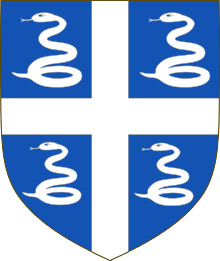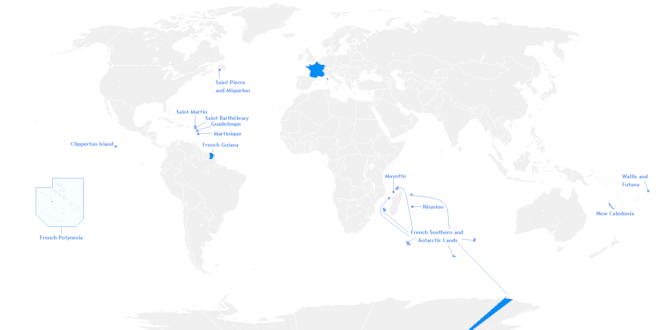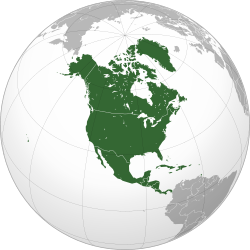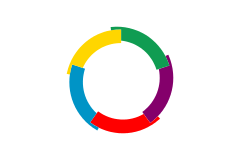Martinique
Martinique (/ˌmɑːrtɪˈniːk/ MAR-tin-EEK, French: [maʁtinik] (![]()
Martinique Matnik / Matinik | |
|---|---|
Overseas Territory/ Overseas Territorial Collectivity (of the French Republic) | |
 | |
| Coordinates: 14°40′N 61°00′W | |
| Overseas territory | France |
| Prefecture | Fort-de-France |
| Departments | 1 |
| Government | |
| • President of Executive Council | Alfred Marie-Jeanne[1] |
| Area | |
| • Total | 1,128 km2 (436 sq mi) |
| Area rank | 17th region |
| Population (2016)[2] | |
| • Total | 376,480 |
| • Density | 330/km2 (860/sq mi) |
| Demonym(s) | Martinican |
| Time zone | UTC-04:00 (ECT) |
| ISO 3166 code | |
| GDP (2012)[3] | Ranked 23rd |
| Total | €8.35 billion (US$10.7 bn) |
| Per capita | €21,527 (US$27,688) |
| NUTS Region | FRA |
| Website | Prefecture, Territorial collectivity |
Virtually the entire population speaks both French, the only official language and Martinican Creole, an Antillean Creole. [6]
Etymology
It is thought that Martinique is a corruption of the native name for the island (Madiana/Madinina, meaning 'island of flowers'), as relayed to Christopher Columbus when he visited the island in 1502.[7] According to historian Sydney Daney, the island was called "Jouanacaëra" by the Caribs, which means "the island of iguanas".
History
.jpg)
Pre-European contact
The island was occupied first by Arawaks, then by Caribs. The Arawaks were described as gentle timorous Indians and the Caribs as ferocious cannibal warriors. The Arawaks came from Central America in the 1st century AD and the Caribs came from the Venezuela coast around the 11th century. When Columbus arrived, the Caribs had massacred many of their adversaries, sparing the women, who they kept for their personal or domestic use.[7]
European arrival and early colonial period
Martinique was charted by Columbus in 1493, but Spain had little interest in the territory.[7] Christopher Columbus landed on 15 June 1502, after a 21-day trade wind passage, his fastest ocean voyage.[7] He spent three days there refilling his water casks, bathing and washing laundry.[8]
On 15 September 1635, Pierre Belain d'Esnambuc, French governor of the island of St. Kitts, landed in the harbour of St. Pierre with 80-150 French settlers after being driven off St. Kitts by the English. D'Esnambuc claimed Martinique for the French King Louis XIII and the French "Compagnie des Îles de l'Amérique" (Company of the American Islands), and established the first European settlement at Fort Saint-Pierre (now St. Pierre).[7] D'Esnambuc died in 1636, leaving the company and Martinique in the hands of his nephew, Jacques Dyel du Parquet, who in 1637, became governor of the island.[7]
In 1636, in the first of many skirmishes, the indigenous Caribs rose against the settlers to drive them off the island. The French successfully repelled the natives and forced them to retreat to the eastern part of the island, on the Caravelle Peninsula in the region then known as the Capesterre. When the Carib revolted against French rule in 1658, the Governor Charles Houël du Petit Pré retaliated with war against them. Many were killed; those who survived were taken captive and expelled from the island. Some Carib had fled to Dominica or St. Vincent, where the French agreed to leave them at peace.
After the death of du Parquet his widow took over the running of the island, however dislike of her rule led King Louis XIV to take over sovereignty of Martinique in 1658.[7] Meanwhile, Dutch Jews, expelled from Portuguese Brazil, introduced sugar plantations worked by enslaved Africans to the island in 1654.[7] Large numbers of slaves were imported from Africa to work these plantations.[7]
In 1667 the Second Anglo-Dutch War spilled out into the Caribbean, with Britain attacking the pro-Dutch French fleet in Martinique, virtually destroying it and further cementing British pre-eminence in the region.[9] In 1674 the Dutch attempted to conquer the island but were repulsed.[7]
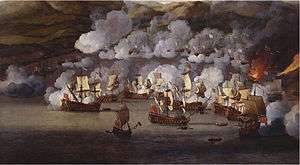
Because there were few Catholic priests in the French Antilles, many of the earliest French settlers were Huguenots who sought greater religious freedom than what they could experience in mainland France. Others were transported there as a punishment for refusing to convert to Catholicism, many of them dying en route. Those that survived were quite industrious and over time prospered, though the less fortunate were reduced to status of indentured servants. Although edicts from King Louis XIV's court regularly came to the islands to suppress the Protestant "heretics", these were mostly ignored by island authorities until Louis XIV's Edict of Revocation in 1685.
As many of the planters on Martinique were themselves Huguenot, and who were sharing in the suffering under the harsh strictures of the Revocation, they began plotting to emigrate from Martinique with many of their recently arrived brethren. Many of them were encouraged by the Catholics who looked forward to their departure and the opportunities for seizing their property. By 1688, nearly all of Martinique's French Protestant population had escaped to the British American colonies or Protestant countries in Europe. The policy decimated the population of Martinique and the rest of the French Antilles and set back their colonisation by decades, causing the French king to relax his policies in the region, which however left the islands susceptible to British occupation over the next century.[10]
Post-1688 period
Under Governor of the Antilles Charles de Courbon, comte de Blénac, Martinique served as a home port for French pirates including Captain Crapeau, Etienne de Montauban, and Mathurin Desmarestz.[11] In later years pirate Bartholomew Roberts styled his jolly roger as a black flag depicting a pirate standing on two skulls labeled "ABH" and "AMH" for "A Barbadian's Head" and "A Martinican's Head", after governors of those two islands sent warships to capture Roberts.[12]
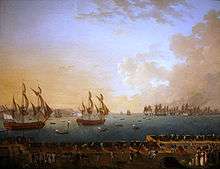
Martinique was attacked or occupied several times by the British, including in 1693, 1759, 1762 and 1779.[7] Excepting a period from 1802 to 1809 following signing of the Treaty of Amiens, Britain controlled the island for most of the time from 1794 to 1815, when it was traded back to France at the conclusion of the Napoleonic Wars.[7][13] Martinique has remained a French possession since then.
Despite the introduction of successful coffee plantations in the 1720s, with Martinique being the first area in the Western hemisphere where coffee was introduced [14], as sugar prices declined in the early 1800s, the planter class lost political influence. Slave rebellions in 1789, 1815 and 1822, plus the campaigns of abolitionists such as Cyrille Bissette and Victor Schoelcher, persuaded the French government to end slavery in the French West Indies in 1848.[15][16][7][13] As a result, some plantation owners imported workers from India and China.[7] Despite the abolition of slavery life scarcely improved for most Martinicans; class and racial tensions exploded into rioting in southern Martinique in 1870 following the arrest of Léopold Lubin, a black trader who retaliated after he was beaten by a Frenchman. After several deaths the revolt was crushed by French militia.[17]
20th–21st centuries
On 8 May 1902, Mont Pelée erupted and completely destroyed St. Pierre, killing 30,000 people.[7] Due to the eruption refugees from Martinique arrived in boats to the southern villages of Dominica with some remaining permanently on the island. In Martinique the only survivor in the town of Saint-Pierre, Auguste Cyparis, was saved by the thick walls of his prison cell.[18] Shortly thereafter the capital shifted to Fort-de-France, where it remains today.[13]
During WWII, the pro-Nazi Vichy government controlled Martinique under Admiral Georges Robert.[7] German U-boats used Martinique for refuelling and re-supply during the Battle of the Caribbean. In 1942, 182 ships were sunk in the Caribbean, dropping to 45 in 1943, and five in 1944. Free French forces took over on the island on Bastille Day, 14 July 1943.[7][19]
In 1946 the French National Assembly voted unanimously to transform the colony into an Overseas Department of France.[7] Meanwhile, the post-war period saw a growing campaign for full independence; a notable proponent of this was the author Aimé Césaire, who founded the Progressive Party of Martinique in the 1950s. Tensions boiled over in December 1959 when riots broke out following a racially-charged altercation between two motorists, resulting in three deaths.[20] In 1962, as a result of this and the global turn against colonialism, the strongly pro-independence OJAM (Organisation de la jeunesse anticolonialiste de le Martinque) was formed. Its leaders were later arrested by the French authorities, however they were later acquitted.[20] Tensions rose again in 1974, when gendarmes shot dead two striking banana workers.[20] However the independence movement lost steam as Martinique's economy faltered in the 1970s, resulting in large scale emigration.[21] Hurricanes in 1979-80 severely affected agricultural output, further straining the economy.[7] Greater autonomy was granted by France to the island in the 1970s-80s[7]
In 2009 Martinique was convulsed by the French Caribbean general strikes. Initially focusing on cost-of-living issues, the movement soon took on a racial dimension as strikers challenged the continued economic dominance of the Béké, descendants of French European settlers.[22][23] President Nicolas Sarkozy later visited the island, promising reform.[24] While ruling out full independence, which he said was desired neither by France nor by Martinique, Sarkozy offered Martiniquans a referendum on the island's future status and degree of autonomy.[24]
Governance
Together with French Guiana, Martinique is one of the Special Collectivity [25] (Unique in french) of the French Republic. It is also an outermost region of the European Union. The inhabitants of Martinique are French citizens with full political and legal rights. Martinique sends four deputies to the French National Assembly and two senators to the French Senate.
On January 24, 2010, during a referendum, the inhabitants of Martinique approved by 68.4% the change to be a “Special (Unique) Collectivity" within the framework of article 73 of the French Republic's Constitution. The new council replaces and exercises the powers of both the General Council and the regional council.
Administrative divisions
Martinique is divided into four arrondissements and 34 communes. The 45 cantons were abolished in 2015. The four arrondissements of the island, with their respective locations, are as follows:
- Fort-de-France is the sole prefecture of Martinique. It takes up the central zone of the island. It includes four communes and sixteen cantons. In 2013 the population was 161,021.[2] Besides the capital, it includes the communities of Saint-Joseph and Schœlcher.
- La Trinité is one of the three subprefectures on the island and occupies the northeast region. It has ten communes and eleven cantons. In 2013 the population was 81,475.[2] La Trinité contains the communities of La Trinité, Ajoupa-Bouillon, Basse-Pointe, Le Gros-Morne, Le Lorrain, Macouba, Le Marigot, Le Robert and Sainte-Marie.
- Le Marin, the second subprefecture of Martinique, makes up the southern part of the island and is composed of twelve communes and thirteen cantons. In 2013 the population was 119,653.[2] The subprefecture includes the communities of La Marin, Les Anses d'Arlet, Le Diamant, Ducos, Le François, Rivière-Pilote, Rivière-Salée, Sainte-Anne, Sainte-Luce, Saint-Esprit, Les Trois-Îlets, and Le Vauclin.
- Saint-Pierre is the third subprefecture of the island. It comprises eight communes and five cantons, lying in the northwest of Martinique. In 2013 the population was 23,402.[2] Together with Saint-Pierre, its communities include Le Carbet, Case-Pilote-Bellefontaine, Le Morne-Rouge, and Le Prêcheur.
Symbols and flags
As a part of the French Republic, the French tricolour is in use and La Marseillaise'’ is sung at national french events. When representing Martinique outside of the island for sport and cultural events the civil flag is 'Ipséité’ and the anthem is ‘Lorizon’ [26]. Martinique Civil ensign is the cross of St Michael (White cross with 4 blue quarters with one snake in each), which is the official civil ensign of Martinique (it also used to be the one of saint lucia. However a coat of arms adaptation of the civil ensign (also called snake flag) is used in an unofficial but formal context such as by the Gendarmerie. The independentists also have their own flag, using a red/black/green colours.
 Civil ensign of Martinique, a St Michael cross with white snakes. Also called 'Snake flag' of Martinique.
Civil ensign of Martinique, a St Michael cross with white snakes. Also called 'Snake flag' of Martinique. The Ipséité is a civil flag sometimes used in international cultural and sporting events.
The Ipséité is a civil flag sometimes used in international cultural and sporting events. Also called ‘red, green and black’, this flag is used by the independence movement.
Also called ‘red, green and black’, this flag is used by the independence movement. Flag of the High Council of Martinique (Collectivité Territoriale de la Martinique).
Flag of the High Council of Martinique (Collectivité Territoriale de la Martinique).
flag of martinique
Geography

Part of the archipelago of the Antilles, Martinique is located in the Caribbean Sea about 450 km (280 mi) northeast of the coast of South America and about 700 km (435 mi) southeast of the Dominican Republic. It is directly north of St. Lucia, northwest of Barbados and south of Dominica.
The total area of Martinique is 1,128 square kilometres (436 sq mi), of which 40 square kilometres (15 sq mi) is water and the rest land.[7] Martinique is the 3rd largest island in The Lesser Antilles after Trinidad and Guadeloupe. It stretches 70 km (43 mi) in length and 30 km (19 mi) in width. The highest point is the volcano of Mount Pelée at 1,397 metres (4,583 ft) above sea level. There are numerous small islands, particularly off the east coast.
The island is volcanic in origin, lying along the subduction fault where the South American Plate slides beneath the Caribbean Plate.[27] Martinique has eight different centres of volcanic activity. The oldest rocks are andesitic lavas dated to about 24 million years ago, mixed with tholeiitic magma containing iron and magnesium. Mount Pelée, the island's most dramatic feature, formed about 400,000 years ago.[28] Pelée erupted in 1792, 1851, and twice in 1902.[18] The eruption of 8 May 1902, destroyed Saint-Pierre and killed 28,000 people in 2 minutes; that of 30 August 1902 caused nearly 1,100 deaths, mostly in Morne-Red and Ajoupa-Bouillon.[29] [30]
The Atlantic, or "windward" coast of Martinique is difficult for navigation by ships. A combination of coastal cliffs, shallow coral reefs and cays, and strong winds make the area a notoriously hazardous zone for sea traffic. The Caravelle peninsula clearly separates the north Atlantic and south Atlantic coast.
The Caribbean, or "leeward" coast of Martinique is much more favourable to sea traffic. In addition to waters off of the leeward coast being shielded from the harsh Atlantic trade winds by the island, the sea bed itself descends steeply from the shore. This ensures that most potential hazards are too deep underwater to be an issue, and it also prevents the growth of corals that could otherwise pose a threat to passing ships.
The north of the island is especially mountainous. It features four ensembles of pitons (volcanoes) and mornes (mountains): the Piton Conil on the extreme North, which dominates the Dominica Channel; Mont Pelée, an active volcano; the Morne Jacob; and the Pitons du Carbet, an ensemble of five extinct volcanoes covered with rainforest and dominating the Bay of Fort de France at 1,196 metres (3,924 ft). Mont Pelée's volcanic ash has created grey and black sand beaches in the north (in particular between Anse Ceron and Anse des Gallets), contrasting markedly from the white sands of Les Salines in the south.
The south is more easily traversed, though it still features some impressive geographic features. Because it is easier to travel to, and due to the many beaches and food facilities throughout this region, the south receives the bulk of the tourist traffic. The beaches from Pointe de Bout, through Diamant (which features right off the coast of Roche de Diamant), St. Luce, the department of St. Anne and down to Les Salines are popular.
Flora and fauna
The northern end of the island catches most of the rainfall and is heavily forested, featuring species such as bamboo, mahogany, rosewood and locust. The south is drier and dominated by savanna-like brush, including cacti, Copaiba balsam, logwood and acacia.
Anole lizards and fer-de-lance snakes are native to the island. Mongooses (Herpestes auropunctatus), introduced in the 1800s to control the snake population, have become a particularly cumbersome introduced species[31] as they prey upon bird eggs and have exterminated or endangered a number of native birds, including the Martinique trembler, white-breasted trembler and white-breasted thrasher.[13]
Economy
In 2014, Martinique had a total GDP of 8.4 billion euros. Its economy is heavily dependent on tourism, limited agricultural production, and grant aid from mainland France.[7]
Historically, Martinique's economy relied on agriculture, notably sugar and bananas, but by the beginning of the 21st century this sector had dwindled considerably. Sugar production has declined, with most of the sugarcane now used for the production of rum.[7] Banana exports are increasing, going mostly to mainland France. The bulk of meat, vegetable and grain requirements must be imported. This contributes to a chronic trade deficit that requires large annual transfers of aid from mainland France.[7]
All goods entering Martinique are charged a variable "sea toll" which may reach 30% of the value of the cargo and provides 40% of the island's total revenue. Additionally the government charges an "annual due" of 1–2.5% and a value added tax of 2.2–8.5%.[32]
Tourism
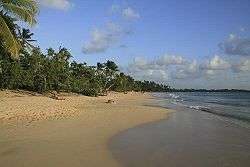
Tourism has become more important than agricultural exports as a source of foreign exchange.[7] Most visitors come from mainland France, Canada and the USA.[7] Roughly 16% of the total businesses on the island (some 6,000 companies) provide tourist-related services.[32]
Infrastructure
Transport
Martinique's main and only airport with commercial flights is Martinique Aimé Césaire International Airport. It serves flights to and from Europe, the Caribbean, Venezuela, the United States, and Canada.[18] See List of airports in Martinique.
Fort-de-France is the major harbour. The island has regular ferry service to Guadeloupe, Dominica and St. Lucia.[13][18] There are also several local ferry companies that connect Fort-de-France with Pointe du Bout.[13]
The road network is extensive and well-maintained, with freeways in the area around Fort-de-France. Buses run frequently between the capital and St. Pierre.[13]
Communications
The country code top-level domain for Martinique is .mq, but .fr is often used instead. The country code for international dialling is 596. The entire island uses a single area code (also 596) for landline phones and 696 for cell phones. (596 is dialled twice when calling a Martinique landline from another country.)[33]
Demographics
Population
Martinique had a population of 385,551 as of January 2013.[2] There are an estimated 260,000 people of Martinican origin living in mainland France, most of them in the Paris region. Emigration was highest in the 1970s, causing population growth to almost stop, but it is comparatively light today.[7]
| 1700 estimate | 1738 estimate | 1848 estimate | 1869 estimate | 1873 estimate | 1878 estimate | 1883 estimate | 1888 estimate | 1893 estimate | 1900 estimate | ||||||||||
|---|---|---|---|---|---|---|---|---|---|---|---|---|---|---|---|---|---|---|---|
| 24,000 | 74,000 | 120,400 | 152,925 | 157,805 | 162,861 | 167,119 | 175,863 | 189,599 | 203,781 | ||||||||||
| 1954 census | 1961 census | 1967 census | 1974 census | 1982 census | 1990 census | 1999 census | 2006 census | 2011 census | 2013 census | ||||||||||
| 239,130 | 292,062 | 320,030 | 324,832 | 328,566 | 359,572 | 381,325 | 397,732 | 392,291 | 385,551 | ||||||||||
| Official figures from past censuses and INSEE estimates | |||||||||||||||||||
Ethnic groups
The population of Martinique is mainly of African descent generally mixed with European, Amerindian (Carib), Indo-Martiniquais (descendants of 19th-century Tamil immigrants from South India), Lebanese, Syrian or Chinese. Martinique also has a small Syro-Lebanese community, a small but increasing Chinese community, and the Béké community, descendants of the first European settlers.[7] Whites in total represent 5% of the population of Martinique.[34]
The Béké population represents around 1% of Martinique's population,[35] most of aristocratic origin by birth or after buying the title. In addition to the island population, the island hosts a mainland French community, most of which live on the island on a temporary basis (generally from 3 to 5 years).
Religion
About 90% of Martinicans are Christian, predominantly Roman Catholic as well as smaller numbers of various Protestant denominations.[7] There are much smaller communities of other faiths such as Islam, Hinduism and Baha'ism.
The majority population is Catholic, which, is represented in each commune or village and has 49 parishes. The island has several historic places of worship, such as the Saint-Louis Cathedral of Fort de France, the Sacred Heart Church of Balata, and the Cathedral of Our Lady of the Assumption of Saint Peter in Martinique.
Jews arrived in Martinique following the arrival of the first European colonists.
Islam made its appearance in Martinique in the 1970s. In 2009, according to the Pew Research Center, there were 1,000 Muslims in Martinique, representing around 0.2 percent of the total population.
Languages
The official language is French, which is spoken by virtually the entire population. In addition, most residents can also speak Martiniquan Creole, a form of Antillean Creole closely related to the varieties spoken in neighboring English-speaking islands of Saint Lucia and Dominica. Martiniquan Creole is based on French, Carib and African languages with elements of English, Spanish, and Portuguese. It continues to be used in oral storytelling traditions and other forms of speech and to a lesser extent in writing.
There was a time when the use of Creole was forbidden in schools and even within families, with French was the only language accepted. Considered as being less prestigious, many Martinicans grew up not speaking Creole. In the 1980s Martinican authors such as Patrick Chamoiseau, Jean Bernabé and Raphaël Confiant attempted to challenge this via the promotion of Creole in a cultural movement known as Créolité.[37] Nowadays, attitudes have changed and the use of Creole is predominant among friends and close family. Though it is normally not used in professional situations, members of the media and politicians have begun to use it more frequently as a way to redeem national identity and prevent cultural assimilation by mainland France. Indeed, unlike other varieties of French creole such as Mauritian Creole, Martinican Creole is not readily understood by speakers of Standard French due to significant differences in grammar, syntax, vocabulary and pronunciation, though over the years it has progressively adopted features of Standard French.
Culture
As an overseas département of France, Martinique's culture blends French and Caribbean influences. The city of Saint-Pierre (destroyed by a volcanic eruption of Mount Pelée), was often referred to as the "Paris of the Lesser Antilles". Following traditional French custom, many businesses close at midday to allow a lengthy lunch, then reopen later in the afternoon.
Today, Martinique has a higher standard of living than most other Caribbean countries. French products are easily available, from Chanel fashions to Limoges porcelain. Studying in the métropole (mainland France, especially Paris) is common for young adults. Martinique has been a vacation hotspot for many years, attracting both upper-class French and more budget-conscious travelers.
Cuisine
Martinique has a hybrid cuisine, mixing elements of African, French, Carib Amerindian and Indian subcontinental traditions. One of its most famous dishes is the Colombo (compare kuzhambu (Tamil: குழம்பு) for gravy or broth), a unique curry of chicken (curry chicken), meat or fish with vegetables, spiced with a distinctive masala of Tamil origins, sparked with tamarind, and often containing wine, coconut milk, cassava and rum. A strong tradition of Martiniquan desserts and cakes incorporate pineapple, rum, and a wide range of local ingredients.
Literature
Aimé Césaire is perhaps Martinique's most famous writer; he was one of the main figures in the négritude literary movement.[38] Other notable writers from Martinique include René Ménil, Étienne Léro, Thélus Léro, Édouard Glissant and Jules-Marcel Monnerot. Frantz Fanon, a prominent critic of colonialism and racism, was also from Martinique; his best known works are Black Skin, White Masks and The Wretched of the Earth.
Music
Martinique has a large popular music industry, which gained in international renown after the success of zouk music in the later 20th century. Zouk's popularity was particularly intense in France, where the genre became an important symbol of identity for Martinique and Guadeloupe.[39] Zouk's origins are in the folk music of Martinique and Guadeloupe, especially Martinican chouval bwa, and Guadeloupan gwo ka. There's also notable influence of the pan-Caribbean calypso tradition and Haitian kompa.
In popular culture
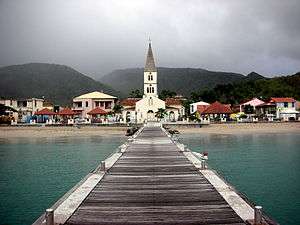
- In 1887, the artist Paul Gauguin lived in Martinique.[40] Gauguin painted the tropical landscape and the native women. The Paul Gauguin Interpretation Centre (former Gauguin Museum) is dedicated to his stay on the island.
- Various films have been set or filmed on Martinique, notably To Have and Have Not, the 1999 remake of The Thomas Crown Affair,Concorde Affaire '79 and Sugar Cane Alley.
- Mexican writer Caridad Bravo Adams wrote Corazón salvaje (published in 1957), which was set in Martinique.
- Several novelists have use the island as a setting, such as Patrick Chamoiseau (Solibo Magnificent), Jean Rhys (Wide Sargasso Sea), Rex Bestle (Martinique Island) and Carolly Erickson (The Secret Life of Josephine: Napoleon's Bird of Paradise).
- Aimé Césaire's seminal poem Cahier d'un retour au pays natal (Notebook of a Return to the Native Land) envisions the poet's imagined journey back to his homeland Martinique to find it in a state of colossal poverty and psychological inferiority due to the French colonial presence.[41][42]
- Lafcadio Hearn in 1890 published a travel book titled Two Years in the French West Indies, in which Martinique [Martinique Sketches] is its main topic; his descriptions of the island, people and history are lively observations of life before the Mont Pelèe eruption in 1902 that would change the island forever. The Library of America republished his works in 2009 entitled Hearn: American Writings.[43][44]
- The Island: Martinique by John Edgar Wideman is a travel memoir of a black man visiting "a place built on slavery" and a "deeply personal journal of his romance with a Frenchwoman" (2003, National Geographic Society).
See also
References
- "Mot du Président de l'Exécutif".
- INSEE. "Recensement de la population en Martinique – 385 551 habitants au 1er janvier 2013" (in French). Retrieved 21 May 2016.
- INSEE, Produits intérieurs bruts régionaux et valeurs ajoutées régionales de 1990 à 2012, retrieved 4 March 2014
- BWETAMO KREYOL MATNIK - Potomitan - Site de promotion des cultures et des langues créoles - Annou voyé kreyòl douvan douvan, Dictionnaire du créole martiniquais, Raphaël Confiant
- "Martinique | Island". Encyclopedia Britannica. Retrieved 24 June 2020.
- Baker, Colin; Jones, Sylvia Prys (1998), Encyclopedia of Bilingualism and Bilingual Education, p. 390, ISBN 978-1853593628
- "Encyclopedia Britannica- Martinique". Retrieved 10 July 2019.
- Morison, Samuel (1942). Admiral of the Ocean Sea. Boston: Little, Brown and Company. pp. 588–589. ISBN 9780316584784.
- "Battle of Martinique, 25 June 1667". Retrieved 10 July 2019.
- History of the Huguenot Migration to America, New York, Dodd, Mead & Company, pp. 205–107
- Gasser, Jacques (1992–1993). "De la mer des Antilles à l'océan Indien (From the Caribbean Sea to the Indian Ocean)". Bulletin du Cercle Généalogique de Bourbon (Bulletin of the Bourbon Genealogical Circle). 38-41. Retrieved 31 August 2017. French language original, as reprinted in Le Diable Volant: Une histoire de la flibuste: de la mer des Antilles à l'océan Indien (1688-1700) / (The Flying Devil: A History of the Filibusters: From the Antilles to the Indian Ocean (1688–1700)).
- Little, Benerson (2016). The Golden Age of Piracy: The Truth Behind Pirate Myths. New York: Skyhorse Publishing, Inc. ISBN 9781510713048. Retrieved 15 September 2017.
- Ver Berkmoes, Ryan; et al. (2008), Caribbean Islands (print)
|format=requires|url=(help) (5th ed.), Lonely Planet - Auguste Lacour, Histoire de la Guadeloupe, vol. 1 (1635–1789). Basse-Terre, Guadeloupe, 1855 full text at Google Books, p. 235ff.
- Robin Blackburn, The Overthrow of Colonial Slavery, 1776–1848 (Verso, 1988), p. 492.
- Sugar and Slavery, Family and Race: The Letters and Diary of Pierre Dessalles, Planter in Martinique, 1808-1856 (Johns Hopkins University Press, 1996), p. 52.
- "MARTINIQUE 1870 : LA GRANDE INSURRECTION DU SUD". Retrieved 10 July 2019.
- Baker, Christopher; et al. (2009), Caribbean (print)
|format=requires|url=(help) (1st ed.), Eyewitness Travel - Hubbard, Vincent (2002). A History of St. Kitts. Macmillan Caribbean. pp. 136–139. ISBN 9780333747605.
- "Emeutes de 1959 : la Martinique règle ses comptes avec le colonialisme". Retrieved 10 July 2019.
- "Le drame de février 1974 marque encore les esprits". Retrieved 10 July 2019.
- "Blacks slam white minority in Martinique strike". International Herald Tribune. Associated Press. 13 February 2009. Retrieved 15 February 2009.
- "Race, class fuel social conflict on French Caribbean islands", Agence France-Presse (AFP), retrieved 17 February 2009
- "Sarkozy offers autonomy vote for Martinique", AFP
- "Archived copy". Archived from the original on 27 May 2019. Retrieved 18 May 2020.CS1 maint: archived copy as title (link)
- Atlas of the World (10th ed.). National Geographic. 2007. p. 6.
- Explore Volcanoes: Mount Pelée, Martinique (web), Maple Creative, c. 2010
- Scarth, Alwyn (2002), La Catastrophe (print)
|format=requires|url=(help), Oxford - Notes, Nature (print)
|format=requires|url=(help), 66, 1902 - Global Invasive Species Database:Martinique
- Informations Economie Martinique, archived from the original on 28 May 2007, retrieved 15 September 2013
- Martinique Telephones, IIWINC, 2013, archived from the original on 29 April 2013, retrieved 23 April 2013
- Martinique: People: Ethnic Groups. World Factbook of CIA
- Béatrice Gurrey et Benoît Hopquin (28 February 2009), "Békés : Une affaire d'héritage", Le Monde (in French)
- "Archived copy" (PDF). Archived from the original (PDF) on 24 October 2018. Retrieved 10 December 2018.CS1 maint: archived copy as title (link)
- Lewis, Shireen K. (2006). Race, Culture and Identity: Francophone West African and Caribbean literature and theory from Négritude to Créolité. Lexington Books. pp. 72–73.
- Ben A. Heller "Césaire, Aimé", in Daniel Balderston et al. (eds) Encyclopedia of Latin American and Caribbean Literature, 1900-2003, London: Routledge, pp. 128–30, 128.
- Ledesma and Scaramuzzo, pp. 289–303
- "Gauguin and Martinique," Karen Kristine Reichnitzer Pope, 1981.
- "Aimé Césaire", in Donald E. Herdeck (ed.), Caribbean Writers: A Bio-Bibliographical-Critical Encyclopedia, Washington, DC: Three Continents Press, 1979, pp. 324–25.
- "Commentary", Notebook of a Return to the Native Land (Middleton, CT: Wesleyan University Press, 2001), p. 53.
- "Two Years in the French West Indies". World Digital Library. Retrieved 22 August 2017.
- Hearn, Lafcadio (1890). Youma: Story of a Western Indian Slave. New York: Harper & Brothers.
External links
- Government
- Martinique : the island of flowers – Official French website (in English)
- Prefecture Région Martinique – Official site
- Regional Council of Martinique – Official site
- General information
- Travel
- Martinique Instamagique – Travel Guide about Martinique
- One Girl One World Guide to Martinique – Travel Blog about Martinique
- Martinique Tourism Authority – Official site
- Zananas Martinique – Informations site


